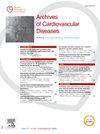动脉粥样硬化小鼠模型中的adp核糖基化:血脂异常与心血管疾病炎症之间的潜在新联系
IF 2.3
3区 医学
Q2 CARDIAC & CARDIOVASCULAR SYSTEMS
引用次数: 0
摘要
炎症和脂质积累是动脉粥样硬化的主要特征,是世界范围内死亡和发病的主要原因。我们之前的研究发现adp -核糖基化是一种翻译后修饰,是巨噬细胞激活的一种新的调节因子。我们还建立了基于质谱的adp核糖基化蛋白质组学。利用这项技术,我们评估了adp核糖基化在动脉粥样硬化发生中的完全未知的作用。目的推测adp核糖化蛋白从肝脏循环,在主动脉蓄积,促进动脉粥样硬化的发生。方法采集低密度脂蛋白受体缺陷(LDL -/-)小鼠的主动脉、肝脏和血浆,分别饲喂常规食物或高脂饮食3或6个月(n = 40/组)。结果为了增加主动脉中adp -核糖基肽的信号,我们应用了我们最新优化的离子迁移率质谱策略来生成adp -核糖基化蛋白质组学数据。我们分析了160只小鼠的主动脉,并在主动脉和肝脏中鉴定了3个APOA1和3个APOE adp核糖化肽(图1a)。此外,与对照组相比,hfd喂养小鼠主动脉中这些肽的丰度存在差异(即APOA1 ARPALEDLR肽的相对丰度[图1b])。使用相同的小鼠血浆,我们分别在HDL和乳糜微粒/VLDL/LDL分数(Western blot)中验证了adp核糖化APOA1和adp核糖化APOE的存在。这一发现表明经典载脂蛋白以adp核糖基化形式循环,代表了一类全新的修饰载脂蛋白。免疫组化证实主动脉病变巨噬细胞和adp -核糖基化信号富集(增加5倍,P = 0.0006)。这项工作首次提供了体内证据,证明adp核糖基化发生在动脉粥样硬化病变中,这可能源于肝脏通过循环血液(图1C)。未来的研究将研究载脂蛋白的adp核糖基化,特别是APOA1,是否会改变HDL的抗动脉粥样硬化功能。本文章由计算机程序翻译,如有差异,请以英文原文为准。
ADP-ribosylation in a mouse model of atherosclerosis: A potential novel link between dyslipidemia and inflammation in cardiovascular disease
Introduction
Inflammation and lipid accumulation are major features of atherosclerosis, a leading cause of death and morbidity worldwide. Our previous study recognized ADP-ribosylation, a post-translational modification, as a novel regulator of macrophage activation. We also have established mass spectrometry-based ADP-ribosylation proteomics. Using this technology, we evaluated the completely uncharacterized role of ADP-ribosylation in atherogenesis.
Objectif We hypothesized that ADP-ribosylated proteins circulate from liver, accumulate in aorta and promote atherogenesis.
Method
We harvested the aorta, liver, and plasma of LDL receptor-deficient (Ldlr-/-) mice that were on a regular chow or high-fat diet for 3 or 6 months (n = 40/condition).
Results
To increase ADP-ribosyl peptide signals in the aorta, we applied our novel recently optimized ion mobility mass spectrometry strategy to generate ADP-ribosylation proteomics data. We analyzed 160 mice aortas and identified 3 APOA1 and 3 APOE ADP-ribosylated peptides in both the aorta and the liver (Fig. 1 A). In addition, these peptides were differentially abundant in the aorta of HFD-fed mice, compared to controls (i.e, APOA1 ARPALEDLR peptide relative abundance [Fig. 1 B]). Using the same mouse plasma, we then validated the presence of ADP-ribosylated APOA1 and ADP-ribosylated APOE in HDL and chylomicron/VLDL/LDL fractions (Western blot), respectively. This finding indicates that classical apolipoproteins circulate as ADP-ribosylated forms, representing a completely novel class of modified apolipoproteins. Immunohistochemistry confirmed the enrichment of aortic lesions in macrophages and ADP-ribosylation signal (5-fold increase, P = 0.0006).
Conclusion
This work provides the first in vivo evidence that ADP-ribosylation occurs in atherosclerotic lesions, which may originate from the liver via circulating blood (Fig. 1C). Future studies will examine whether ADP-ribosylation of apolipoproteins, specifically APOA1, alters anti-atherogenic functions of HDL.
求助全文
通过发布文献求助,成功后即可免费获取论文全文。
去求助
来源期刊

Archives of Cardiovascular Diseases
医学-心血管系统
CiteScore
4.40
自引率
6.70%
发文量
87
审稿时长
34 days
期刊介绍:
The Journal publishes original peer-reviewed clinical and research articles, epidemiological studies, new methodological clinical approaches, review articles and editorials. Topics covered include coronary artery and valve diseases, interventional and pediatric cardiology, cardiovascular surgery, cardiomyopathy and heart failure, arrhythmias and stimulation, cardiovascular imaging, vascular medicine and hypertension, epidemiology and risk factors, and large multicenter studies. Archives of Cardiovascular Diseases also publishes abstracts of papers presented at the annual sessions of the Journées Européennes de la Société Française de Cardiologie and the guidelines edited by the French Society of Cardiology.
 求助内容:
求助内容: 应助结果提醒方式:
应助结果提醒方式:


